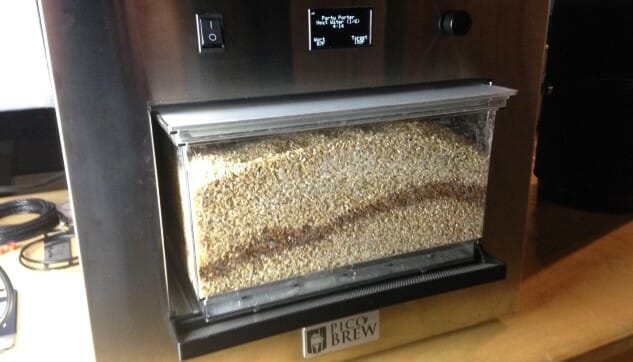PicoBrew Zymatic: The $2,000, all-in-one Homebrewing Machine
Photos via Jim Vorel
In the end, no matter how you slice it, homebrewing is a hobby that involves a fair amount of work and patience. There’s a booming market of gadgetry involved in making the job easier and faster, but no matter what kind of technology you’re employing, brewing—and all-grain brewing in particular—is a process that eats up chunks of time both on brew day, bottling day, etc. Hot water still has to hit malt, temperatures need to be maintained, yeast needs to be pitched and time needs to pass.
Still, there’s always that dream of being able to homebrew effortlessly, and that’s where the PicoBrew Zymatic comes in. The Zymatic is a large, boxy, chrome machine that works as an all-in-one homebrewing device, designed to automate as many parts of the process as possible. You may have heard of it during the device’s very successful Kickstarter cycle, when it raised $661,000. But the machine is now commercially available to everyone—provided, of course, you feel like dropping a couple grand. As a homebrewer of eight years, I was certainly curious how it might be compared to my own experience with the hobby, and so we jumped at the chance when Paste was offered an opportunity to take a Zymatic through its paces.
The machine
I decided to test the machine out by attempting a full brew cycle during the course of a normal work day at the Paste offices … and yes, I realize how awesome it is that I can say this is a fairly typical part of my job description. Immediately, I ran into a hangup or two in setting up and minor assembly—there’s very little that actually needs to be done, and it’s easy work for the mechanically inclined, but I was in particular confused by text in the instruction manual that proved to be either confusing or straight-up incorrect. Reconnecting with the PicoBrew team, I received prompt explanations and an assurance that the instruction manual would be corrected.
The Zymatic essentially works by connecting to a standard 5-gallon soda/beer keg, often known as a “corny” or Cornelius keg, and circulating water from the keg into the machine, where it is heated to the proper temperature and then passed into a large grain bin in order to conduct the mash. The hot, sugary water (known as “wort”) is then heated to boiling temperature and passed through several hop cages the conduct your boil. All of this is completely automated at the push of a button. The Zymatic knows specifically what temperatures it should be holding because the recipe for each of the company’s kits is uploaded to it wirelessly—it connects with your own computer, in this case my laptop, allowing you to follow the process along on your screen as it goes through its paces. This is significant, as it also logs all of the data for each session, which can be revisited. It’s the kind of data I keep in my own brewing notebook at home.
Wanting to test the machine exactly as intended, we made our own “Party Porter” kit exactly as it was delivered to us. There are a few things to note here that homebrewers will want to be aware of:
- The standard batch size on the Zymatic is 2.5 gallons, which is half of what is usually considered “typical” in homebrewing batches. It’s a trade-off: Less finished beer, but added incentive for experimentation.
- That batch size is basically dictated by the size of the grain bin that fits into the Zymatic. For our kit, a beer with an intended ABV of roughly 7%, it was a maximum grain load for the machine—meaning that 7% ABV is roughly the maximum alcohol percentage you can do with a single-infusion mash. There are settings, however, to recirculate the mash water and extract more sugars in order to make beers stronger than 7%. Of course, the trade-off is that this will add to the time of the brew cycle.
- I found the actual included recipe a little curious, particularly in the fact that it was labeled as a “porter.” At 7% ABV, it’s already stronger than you would expect, and the one dark malt in the grain bill is unmalted, roasted barley—the one type of dark malt that one typically differentiates stout from porter, although those terms are quite nebulous. These are obviously only issues of nomenclature, but if I was looking at the recipe without a name on it, I’d tell you it’s “American stout,” albeit with a lower hop rate.
The brew cycle
Once we’d figured out technical issues of set-up, the machine ran through its actual brew cycle admirably. Through my own error, I added slightly too much water to the keg in the initial phase (my measuring left something to be desired), which resulted in the grain bin overflowing a bit, but there’s a drip tray to collect the spill.
-

-

-

-

-

-

-

-

-

-

-

-

-

-

-

-

-

-

-

-

-

-

-

-

-

-

-

-

-

-

-

-

-

-

-

-

-

-

-

-









































